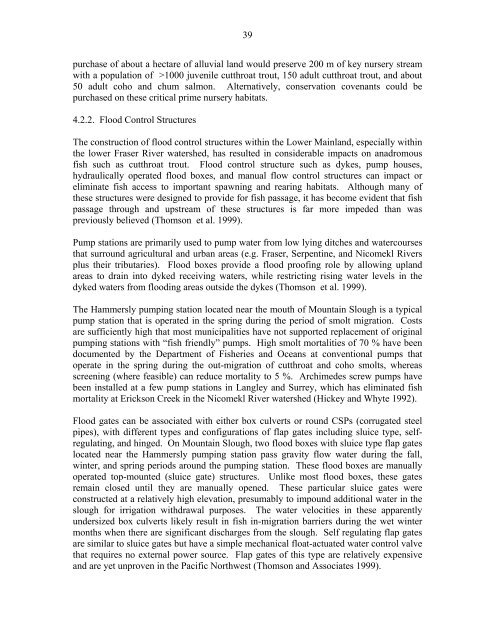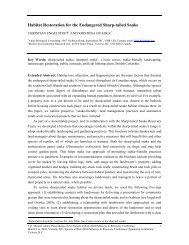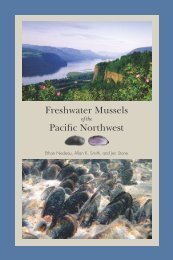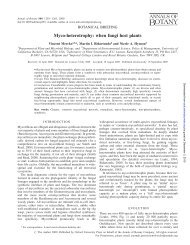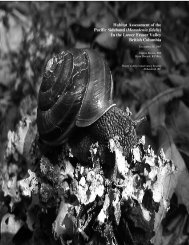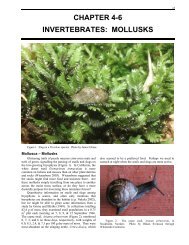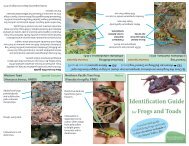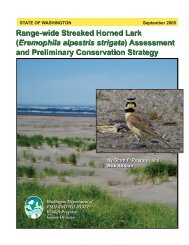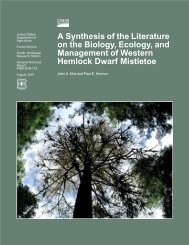Coastal Cutthroat Trout as Sentinels of Lower Mainland Watershed ...
Coastal Cutthroat Trout as Sentinels of Lower Mainland Watershed ...
Coastal Cutthroat Trout as Sentinels of Lower Mainland Watershed ...
You also want an ePaper? Increase the reach of your titles
YUMPU automatically turns print PDFs into web optimized ePapers that Google loves.
39purch<strong>as</strong>e <strong>of</strong> about a hectare <strong>of</strong> alluvial land would preserve 200 m <strong>of</strong> key nursery streamwith a population <strong>of</strong> >1000 juvenile cutthroat trout, 150 adult cutthroat trout, and about50 adult coho and chum salmon. Alternatively, conservation covenants could bepurch<strong>as</strong>ed on these critical prime nursery habitats.4.2.2. Flood Control StructuresThe construction <strong>of</strong> flood control structures within the <strong>Lower</strong> <strong>Mainland</strong>, especially withinthe lower Fr<strong>as</strong>er River watershed, h<strong>as</strong> resulted in considerable impacts on anadromousfish such <strong>as</strong> cutthroat trout. Flood control structure such <strong>as</strong> dykes, pump houses,hydraulically operated flood boxes, and manual flow control structures can impact oreliminate fish access to important spawning and rearing habitats. Although many <strong>of</strong>these structures were designed to provide for fish p<strong>as</strong>sage, it h<strong>as</strong> become evident that fishp<strong>as</strong>sage through and upstream <strong>of</strong> these structures is far more impeded than w<strong>as</strong>previously believed (Thomson et al. 1999).Pump stations are primarily used to pump water from low lying ditches and watercoursesthat surround agricultural and urban are<strong>as</strong> (e.g. Fr<strong>as</strong>er, Serpentine, and Nicomekl Riversplus their tributaries). Flood boxes provide a flood pro<strong>of</strong>ing role by allowing uplandare<strong>as</strong> to drain into dyked receiving waters, while restricting rising water levels in thedyked waters from flooding are<strong>as</strong> outside the dykes (Thomson et al. 1999).The Hammersly pumping station located near the mouth <strong>of</strong> Mountain Slough is a typicalpump station that is operated in the spring during the period <strong>of</strong> smolt migration. Costsare sufficiently high that most municipalities have not supported replacement <strong>of</strong> originalpumping stations with “fish friendly” pumps. High smolt mortalities <strong>of</strong> 70 % have beendocumented by the Department <strong>of</strong> Fisheries and Oceans at conventional pumps thatoperate in the spring during the out-migration <strong>of</strong> cutthroat and coho smolts, where<strong>as</strong>screening (where fe<strong>as</strong>ible) can reduce mortality to 5 %. Archimedes screw pumps havebeen installed at a few pump stations in Langley and Surrey, which h<strong>as</strong> eliminated fishmortality at Erickson Creek in the Nicomekl River watershed (Hickey and Whyte 1992).Flood gates can be <strong>as</strong>sociated with either box culverts or round CSPs (corrugated steelpipes), with different types and configurations <strong>of</strong> flap gates including sluice type, selfregulating,and hinged. On Mountain Slough, two flood boxes with sluice type flap gateslocated near the Hammersly pumping station p<strong>as</strong>s gravity flow water during the fall,winter, and spring periods around the pumping station. These flood boxes are manuallyoperated top-mounted (sluice gate) structures. Unlike most flood boxes, these gatesremain closed until they are manually opened. These particular sluice gates wereconstructed at a relatively high elevation, presumably to impound additional water in theslough for irrigation withdrawal purposes. The water velocities in these apparentlyundersized box culverts likely result in fish in-migration barriers during the wet wintermonths when there are significant discharges from the slough. Self regulating flap gatesare similar to sluice gates but have a simple mechanical float-actuated water control valvethat requires no external power source. Flap gates <strong>of</strong> this type are relatively expensiveand are yet unproven in the Pacific Northwest (Thomson and Associates 1999).


